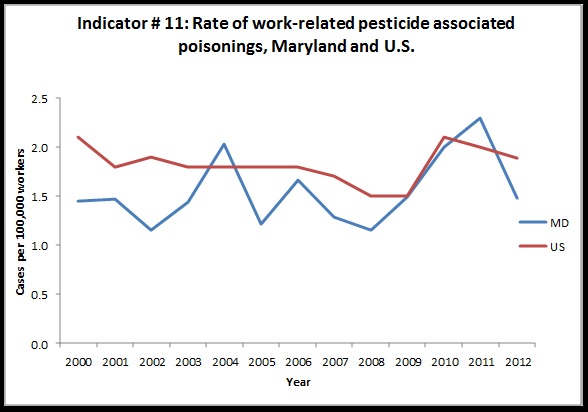Indicator #11: Acute Work-Related Pesticide Poisonings Reported to Poison Control Centers

A pesticide is a substance or mixture of substances used to prevent or control undesired insects, plants, animals, or fungi. In the U.S., approximately one billion pounds of pesticides are used annually, contained in more than 16,000 pesticide products. Although the value of pesticides in protecting the food supply and controlling disease vectors is well recognized, it is also recognized that pesticides can cause harm to people and the environment. Adverse health effects from exposure vary depending on the amount and route of exposure and the type of chemical used. Agricultural workers and pesticide applicators are at greatest risk for the more severe pesticide poisonings.
Graph

Table
Indicator # 11: Acute Work Related Pesticide Associated Illness and Injury Reported to Poison Control Centers, Maryland
| Year |
Number |
Rate* |
| *Cases per 100,000 workers |
| 2000 |
39 |
1.45 |
| 2001 |
40 |
1.47 |
| 2002 |
32 |
1.15 |
| 2003 |
40 |
1.44 |
| 2004 |
56 |
2.03 |
| 2005 |
34 |
1.21 |
| 2006 |
48 |
1.66 |
| 2007 |
37 |
1.29 |
| 2008 |
33 |
1.15 |
| 2009 |
42 |
1.49 |
| 2010 |
57 |
2.0 |
| 2011 |
67 |
2.3 |
| 2012 |
43 |
1.5 |
More about this indicator
Why is this indicator important?
Workers who handle pesticides are at increased risk for exposure. Poison Control Centers (PCCs) are important sources of reports of acute poisonings and chemical exposures. These data can be useful to target prevention. The type of data collected is comparable across states due to the uniformity in case handling by PCCs.
Data Source for this Indicator
American Association of Poison Control Centers (Numbers of pesticide-associated illness and injury); Bureau of Labor Statistics Current Population Survey (total number of employed persons).
U.S. data and information about this indicator obtained from http://www.cste.org/general/custom.asp?page=OHIndicators
Limitation of Indicator:
Poison Control Centers capture only a small proportion of acute occupational pesticide-related illness cases, an estimated 10%. PCCs do not systematically collect information on industry and occupation.

